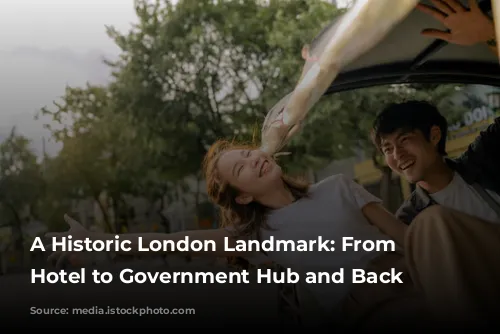The Corinthia Hotel London, a majestic structure perched on the corner of Northumberland Avenue and Whitehall Place, holds a rich history intertwined with London’s past. This imposing building, located between Trafalgar Square and the Thames Embankment, has witnessed the city’s evolution and played a pivotal role in its historical narrative.
From Luxury Hotel to Government Quarters
Originally christened the Metropole Hotel, it opened its doors in 1885, drawing in London’s elite with its grandeur and proximity to the Palace of Westminster and the bustling Whitehall. Its strategic location, however, led to a different kind of destiny. In both World Wars, the hotel was commandeered by the government, transformed into a temporary home for officials and war strategists. After the Second World War, the Ministry of Defence took possession of the property, using it as government offices until its surplus status led to its sale in 2007.
A Legacy of Royal Visits and Notable Events
The Metropole Hotel, in its heyday, played host to a string of prestigious events and dignitaries. It was the chosen venue for the annual dinners of the Aero Club and the Alpine Club, while the first London to Brighton run in 1896 saw the hotel become the gathering point for eager competitors. The Prince of Wales, later King Edward VII, held court in the hotel’s grand ballroom, using the Royal Suite as his personal haven.

A Tapestry of Music and Entertainment
After the First World War, the hotel reopened its doors as a luxury hotel, attracting the attention of a diverse clientele. The “Midnight Follies” became a popular cabaret act, drawing in crowds eager for a night of entertainment. In 1921, a young musician named Bert Firman joined the hotel’s orchestra. A stroke of luck allowed him to take over the role of bandleader, becoming the youngest bandleader in the world at just 16 years old. The hotel’s musical heritage continued to flourish, with other notable musicians like Mantovani taking the stage during the interwar years.

A Sporting Triumph
The Metropole Hotel witnessed a historic moment in the annals of rugby. In 1936, the England Rugby Union team, led by the legendary Prince Alexander Obolensky, defeated the touring New Zealand All Blacks in a dramatic match. Prince Obolensky’s try, a dazzling display of skill and agility, was widely hailed as one of the greatest tries ever scored by England, cementing his place in rugby history. The England team celebrated their victory at the Metropole, sharing the space with the opposing team.

A Government Lifeline
The hotel’s central location made it an attractive option for the government, who, in the mid-1930s, leased the entire building to accommodate growing government offices. The Ministry of Labour, the Ministry of Transport, the Air Ministry, and eventually the Ministry of Defence all called the Metropole their temporary home.

A Secret Wartime Hub
In the lead-up to the Second World War, the government once again requisitioned the Metropole Hotel, solidifying its role as a vital center for war efforts. The building played host to several government departments, including the MI9, a secret intelligence agency, and the Special Operations Executive (SOE).

A Lasting Legacy
The Metropole Hotel was purchased by Gordon Hotels after the war, eventually becoming part of the Crown Estate portfolio. The Ministry of Defence continued to utilize the building as an overflow space for its Whitehall headquarters. This period saw the Air Ministry return as a major occupant, while the Defence Intelligence Staff made the Metropole their home for several decades.

A Return to Splendor
After standing vacant for several years, the Metropole Building, as it came to be known, was acquired by a consortium in 2007, paving the way for a remarkable transformation. The building was meticulously restored and reopened in 2011 as the Corinthia Hotel London, a luxurious hotel and residential complex. The hotel’s design pays homage to its history, while embracing a contemporary aesthetic.

A Star-Studded Past
The Corinthia Hotel, in its latest incarnation, has become a favorite haunt of the film industry, with scenes from several blockbuster movies shot within its walls. The official announcement of the James Bond movie Skyfall was made at the hotel in 2011, while the thriller Red Sparrow, featuring Jennifer Lawrence, featured scenes both inside and outside the hotel.

A Creative Space for Artists
The hotel’s commitment to fostering creativity is evident in its Artist in Residence program, which began in 2011. The program showcases the work of talented writers, theatre companies, and filmmakers, creating a platform for artistic expression and innovation. The hotel’s commitment to art and culture ensures that its rich history continues to evolve and inspire.

A Timeless Symbol
The Corinthia Hotel London stands as a testament to London’s resilience and its ability to adapt to changing times. From a grand hotel catering to the city’s elite to a crucial center for government operations and now a luxurious hotel complex, the building has witnessed London’s growth and transformation firsthand. Its presence in the heart of the city serves as a reminder of London’s vibrant past and its enduring spirit.



